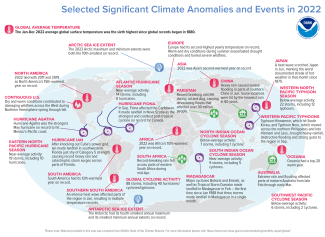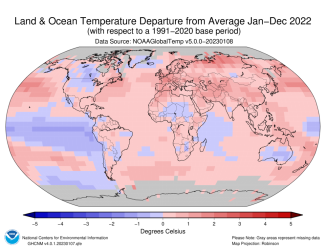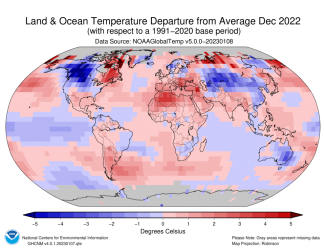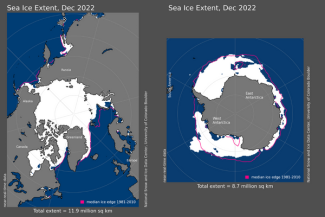The globe had its sixth-warmest year on record

According to NOAA scientists, the global surface temperature for 2022 was the sixth highest since record keeping began in 1880. In a separate analysis of global temperature data also released today, NASA ranks 2022 as the fifth-warmest year on record, tying with 2015. Analysis from the Copernicus program ranked 2022 as the fifth-warmest year on record. December’s global surface temperature was the eighth highest in the 143-year record, according to NOAA.
This summary from NOAA National Centers for Environmental Information is part of the suite of climate services that NOAA provides to government, business, academia, and the public to support informed decision-making.
Global Climate Highlights: 2022
Global land and ocean surface temperature: The 2022 average temperature across global surfaces was 1.55°F (0.86°C) above the 20th-century average of 57.0°F (13.9°C) – the sixth highest among all years in the 1880-2022 record. This was also the 46th-consecutive year (since 1977) with global temperatures, at least nominally, above the 20th-century average. The 10-warmest years on record have all occurred since 2010, with the last nine years (2014-2022) among the 10-warmest years.
For the 21-year span (1880–1900) that is considered a reasonable surrogate for pre-industrial conditions, the 2022 global land and ocean temperature was 1.90°F (1.06°C) above average. The annual global surface temperature has increased at an average rate of +0.14°F (+0.08°C) per decade since 1880; however, since 1981 the average rate of increase is more than twice that rate (+0.32°F / +0.18°C).
The 2022 Northern Hemisphere surface temperature was also the sixth highest in the 143-year record at 1.98°F (1.10°C) above average. The Southern Hemisphere surface temperature for 2022 was the seventh highest on record at 1.10°F (0.61°C) above average.
Much-warmer-than-average temperatures were observed across most of the globe during 2022. Record-high temperatures were measured across parts of Europe, southern Asia, and the North and southwestern Pacific Ocean, as well as the Atlantic and southeastern Pacific oceans. Cooler-than-average temperatures were limited to the central and eastern tropical Pacific Ocean, consistent with an episode of cold phase El Niño Southern Oscillation (ENSO), also known as La Niña, that persisted throughout the year.
Regionally, Europe and Asia had their second-warmest year, behind 2020. Africa had its 10th-warmest year, while North America, South America, and Oceania had a top-20 warm year.
Global ocean heat content (OHC): The upper ocean heat content, which addresses the amount of heat stored in the 0-2000 meters depth of the ocean, was record high in 2022, surpassing the previous record set in 2021. The four highest OHC have all occurred in the last four years (2019-2022).
2022 Snow and Sea Ice Information
Northern Hemisphere snow cover: According to NOAA data analyzed by the Rutgers Global Snow Lab, the average annual Northern Hemisphere snow cover extent for 2022 was near average at 9.60 million square miles. Snow cover extent records extend back to 1967.
Arctic sea ice extent: During 2022, the months of March, June, and October through December each had a sea ice extent that ranked among the 10 lowest extents for their respective month. However, no month had a record low sea ice extent during the year. When averaging monthly data from the National Snow and Ice Data Center, the average annual sea ice extent in the Arctic was approximately 4.13 million square miles – the 11th-smallest annual average sea ice extent in the 1979-2022 record. The 10 lowest Arctic sea ice extents have all occurred since 2007, with the years of 2015-2021 ranking among the 10 smallest on record.
Antarctic sea ice extent: The 2022 annual Antarctic sea ice extent was at a near-record low at 4.09 million square miles. Only the year 1987 had a smaller annual extent. During the year, each month had an extent that ranked among the five smallest for their respective months, while the months of February, June, July, and August had their lowest monthly extent on record.
2022 Global Tropical Cyclones
A total of 88 named storms occurred across the globe in 2022, which was near the 1991-2020 average. Of those, 40 reached tropical cyclone strength (winds ≥ 74 mph) and 17 reached major tropical cyclone strength (winds ≥ 111 mph). Both of these counts were below their 1991-2020 averages. The global accumulated cyclone energy (ACE: an integrated metric of the strength, frequency, and duration of tropical storms) was the fourth lowest since 1981.
The North Atlantic (14 named storms), the East North Pacific (19), and the South Indian (nine) basins had near-average tropical cyclone activity in 2022. For a third-consecutive year, the West Pacific basin had a below-average activity with 22 named storms. The North Indian (seven), the Australian (12), and the Southwest Pacific (6) basins also had below-average activity in 2022. No basins had above-average activity.
Global Climate Highlights: December 2022
Global land and ocean surface temperature: For December, the average temperature across global land and ocean surfaces was 1.44°F (0.80°C) above the 20th-century average. This value ranks as the eighth-highest December temperature departure from average in the 143-year NOAA record.
Regionally, Africa tied 2016 for its second-warmest December on record. South America’s December ranked fourth warmest on record, and December in Europe ranked 10th warmest. Although North America and Asia both had an above-average December temperature, it did not rank among the 20 warmest on record. Oceania also had a warmer-than-average December, but it was the region’s coolest December in more than 10 years.
Northern Hemisphere snow cover: According to data from NOAA analyzed by the Rutgers Global Snow Lab, the Northern Hemisphere snow cover extent during December was 270,000 square miles below the 1991-2020 average and ranked as the 21st-lowest December extent on record. North America and Greenland’s combined December extent ranked 13th-largest on record. Meanwhile, Eurasian snow cover extent for December was well below average and ranked as the 10th smallest extent on record.
Arctic sea ice extent: The average Arctic sea ice extent for December was 4.60 million square miles, according to analysis by the National Snow and Ice Data Center (NSIDC) based on data from NOAA and NASA. This ranks as the seventh-lowest December extent on record.
Antarctic sea ice extent: Antarctic sea ice extent during December was 3.36 million square miles, which was about 660,000 square miles below the 1991-2020 average. This ranks as the second-lowest December extent after 2016 in the 44-year satellite record.
See our full report for a more complete summary of climate conditions and events.








